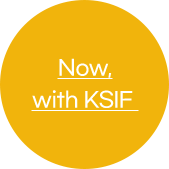

Practical Translation and Interpretation
Teaching Methods That Go Beyond
Language to Convey Cultural Context
An Interview with Professor Shin Yoon-kyeong
of the Korean Studies Program
at Gachon University’s College
of International Studies
For over 30 years, Professor Shin Yoon-kyeong has dedicated herself to Korean language and culture education for
foreigners. Recently, she has been focusing on a new trend that integrates Korean language education with
translation and interpretation training, bringing practical change to classrooms across the field. On June 24,
during the Korean Translation and Interpretation Teacher Training Workshop at KSI held in Ho Chi Minh City,
Vietnam, Professor Shin gave a lecture titled “Translation and Interpretation Theory and Teaching Methods.” We
sat down with her to learn more about the contents of her lecture and to explore the significance and potential
of translation and interpretation education in the Korean language learning landscape.
Hello, Professor Shin Yoon-kyeong. Thank you for joining us for this interview. To begin, could you please
introduce yourself to the readers of Monthly Knock Knock and tell us about your areas of research and
teaching?
Hello. My name is Shin Yoon-kyeong, and I am a professor in the Department of Korean Studies at the College of
International Studies, Gachon University. I have spent over 30 years in the field of Korean language and culture
education for foreign learners. Recently, my academic interests have focused on exploring integrated approaches
that connect Korean language education with translation and interpretation training.
Currently, I also serve as the founding president of the International Network for Korean Interpretation and
Translation (KIT). KIT is committed to expanding the scope and boundaries of Korean language education by
pioneering a new field: Korean translation and interpretation education for non-native speakers. We regularly
host seminars and online workshops with researchers and practitioners both in Korea and abroad, and we have also
developed and are currently administering the Korean Translation and Interpretation Proficiency Test, which
assesses learners’ skills and provides clear developmental pathways.
The core goal of the institute is to closely link academic theory with real-world teaching practice and to help
learners from various cultural backgrounds use their language abilities in socially meaningful ways. Moving
forward, we plan to continue pursuing a wide range of international collaborations and research initiatives.
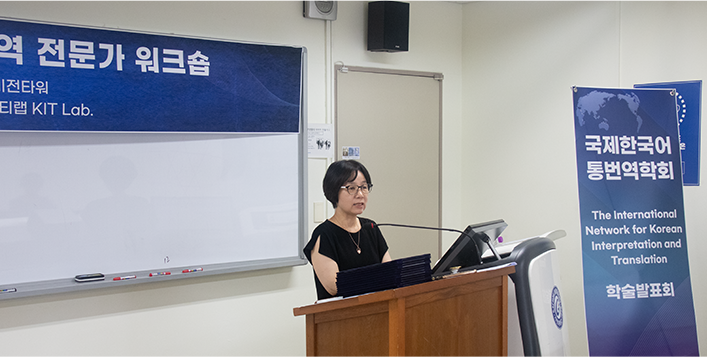 Professor Shin Yoon-kyeong presenting at an academic conference hosted by the International Network for Korean
Interpretation and Translation (KIT)
Professor Shin Yoon-kyeong presenting at an academic conference hosted by the International Network for Korean
Interpretation and Translation (KIT)
On June 24, you gave a lecture titled “Translation and Interpretation Theory and Teaching Methods” at the
Korean Translation and Interpretation Teacher Training Workshop at KSI held in Ho Chi Minh City, Vietnam.
Could you tell us what topics you focused on during the session?
This lecture was designed for Korean language teachers currently teaching or preparing to teach translation and
interpretation courses at KSIs. Under the theme “Translation and Interpretation Theory and Teaching Methods,” I
conducted a two-hour session focusing on both the theoretical foundations of translation education and practical
strategies for classroom application.
In the first part, I introduced international competence-based models such as the European Master’s in
Translation Competence Framework (EMT) and the Process of Acquisition of Translation Competence and Evaluation
(PACTE) model. These frameworks provided a theoretical background and highlighted the importance of translation
and interpretation education. I aimed to help teachers adopt the perspective of educators who go beyond simply
transferring language, emphasizing the role of conveying meaning across languages and serving as cultural
mediators.
The second part of the session focused on practice-based instructional design using training models. I guided
participants through activities such as setting translation goals, discussing strategies for literal versus free
translation, and conducting simple consecutive interpreting exercises. I also introduced teaching methods that
take into account learners’ language proficiency and cultural backgrounds, along with post-editing strategies
tailored to the era of AI-based machine translation—offering practical tools that can be readily implemented in
the classroom.
This workshop was part of KSIF’s broader effort to systematize translation and interpretation education for
foreign learners. Its main objective was to support teachers in effectively designing and delivering such
courses. As the president of the International Network for Korean Interpretation and Translation (KIT), it was
also a meaningful opportunity to emphasize the importance of hands-on translation education and explore the
direction of Korean translation and interpretation training aligned with international standards.
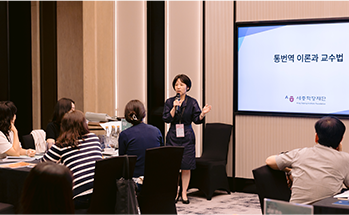
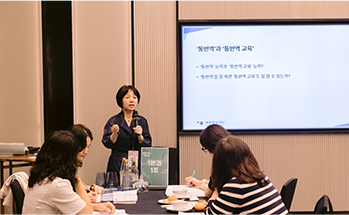
Professor Shin Yoon-kyeong delivering a lecture on “Translation and Interpretation Theory and
Teaching Methods” at the Korean Translation and Interpretation Teacher Training Workshop at KSI
We heard that you designed the training program for this workshop, which was tailored for local Vietnamese
translation and interpretation teachers. Could you share what you considered during the program design
process?
The core objective of this workshop was to provide practical training that goes beyond one-way lectures—training
that builds tailored competencies based on the type of instructor. One of the key features of the program was
dividing the participants into two groups: Korean teachers and local Vietnamese teachers, and customizing the
content accordingly. By adjusting instructional strategies and practice directions based on each group’s
language background and teaching environment, we aimed to enhance both the practicality and effectiveness of the
training so it could be applied directly in real classroom settings.
Korean teachers, being native Korean speakers, have strengths in grasping theoretical foundations and
instructional design for translation and interpretation education. For them, we structured the sessions around
multi-competency-based translation theories and training models such as the European Master’s in Translation
Competence Framework (EMT) and the Process of Acquisition of Translation Competence and Evaluation (PACTE)—with
a focus on strategies for applying these models in classroom instruction. On the other hand, local Vietnamese
teachers have a strong advantage in understanding and communicating within the learners’ native language and
cultural context. Accordingly, the training for them emphasized native-language-based feedback strategies,
cross-cultural meaning adjustment, and learner-centered interaction methods.
In addition, we incorporated practice-based activities such as shadowing, reverse interpreting, and
post-editing, all supported by a rubric-based evaluation system. This allowed teachers to not only experience
instructional methods firsthand but also to design and assess their own lessons. Ultimately, this workshop
served to demonstrate that KSI’s translation and interpretation courses are not limited to textbook-driven
instruction. Rather, they are designed as flexible programs that maximize educational effectiveness by
leveraging each teacher’s unique strengths.
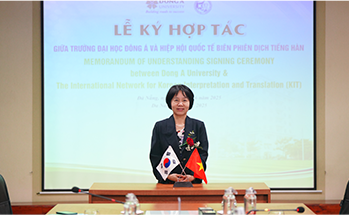
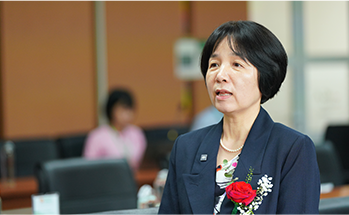
Professor Shin Yoon-kyeong at the 39th International Conference co-hosted
by the International Network for Korean Language and Culture (INK) and the International Network
for Korean Interpretation and Translation (KIT)
Your lecture on translation and interpretation theory and teaching methods seems highly applicable not only in
Vietnam but also for Korean language teachers around the world who are engaged in Korean translation and
interpretation education. Could you share how these methods can be utilized more broadly and what key points
teachers should keep in mind when applying them?
The translation and interpretation theory and teaching methods I presented are not limited to a specific
country—they are designed as an educational model with universal applicability and flexibility in multilingual
and multicultural contexts. In particular, they are highly suitable for classes targeting intermediate to
advanced learners, where practical language performance and goal-oriented training are required.
First, when applying them in the classroom, it’s important to view “translation” and “interpretation” not as
separate skills, but as a continuous process of meaning transfer between languages. For example, in a
translation class, the goal should not be to find a single correct answer, but to help learners choose
appropriate strategies based on the purpose, audience, and genre of the text. Post-editing activities using
machine translation (AI) and simple consecutive interpretation practices are easily adaptable to classroom
settings.
These activities can significantly enhance learners’ language performance. Above all, it's essential to design
lessons with full consideration of learners’ linguistic backgrounds and cultural contexts. Because translation
and interpretation education goes beyond language skills to include intercultural understanding and contextual
interpretation, the central guiding question should always be: “Who is this class for?”
In summary, translation and interpretation education is no longer solely for training professionals; it is a
strategy for advancing language education and fostering intercultural communication competence. If Korean
language teachers around the world apply these methods flexibly to suit the needs of their learners and
educational environments, translation and interpretation classes can become a highly meaningful experience—for
both the learners and the teachers themselves.
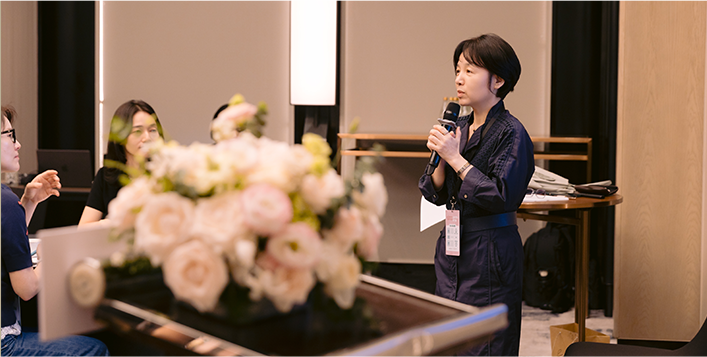
Finally, how do you foresee the demand and future outlook for Korean translation and interpretation education?
And in relation to that, what should the KSIF be preparing for moving forward?
With the global spread of Hallyu, the expansion of Korean businesses overseas, and the increase in multicultural
exchanges, the global demand for Korean translation and interpretation education is rapidly growing. In
particular, the need for translation of media content and on-site interpretation in fields such as business,
healthcare, and tourism continues to rise. As a result, the demand for highly skilled professionals with
advanced Korean translation and interpretation capabilities will only become greater.
Moreover, with the advent of AI-powered automatic translation tools, the translation and interpretation market
is shifting toward post-editing and high-level interpretation skills. This trend underscores the increasing need
for professionals who can go beyond simple language transfer to deliver accurate and culturally nuanced
communication.
KSIF has already piloted the translation and interpretation program at KSIs three times and is now operating it
as a formal curriculum. It has also published textbooks in 16 different languages. To further activate this
program, it will be essential to institutionalize training sessions like the recent Korean Translation and
Interpretation Teacher Training Workshop at KSI, and to strengthen teacher capacity by offering ongoing
education in translation and interpretation theory and teaching methods for Korean language instructors.
In addition, KSIF should build a digital ecosystem by leveraging its existing online platform—offering online
workshops, AI-based training, joint research, and a translation and interpretation case database. This would
create a foundation for KSIs around the world to share knowledge and resources and collaborate continuously.
Lastly, the establishment and operation of a certification system—such as a Korean Translation and
Interpretation Proficiency Test—would not only motivate learners and teachers but also enhance the professional
standing of KSIs. The International Network for Korean Interpretation and Translation (KIT) is open to
collaborating in this effort. Translation and interpretation education is no longer a supplementary course; it
is now a core competency in the global language services market and a critical resource in fields such as Hallyu
content, business, healthcare, and tourism.